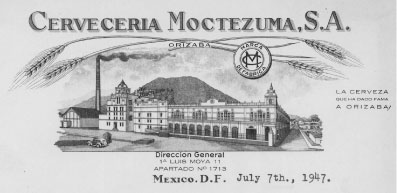Mexico, which produces one of the best recognized and top-selling beer brands in the world, has a beer history that is often surprising to foreigners.
Historically, the Mexican beer industry has been greatly influenced by German and Austrian immigrants who started breweries in Mexico during the short-lived (and, in the nearby United States, completely forgotten) reign between 1864 and 1867 of Austrian-born Mexican Emperor Maximiliano I. In the late 19th century this influence continued, and a number of distinctly Germanic breweries were founded. In particular, the Vienna lager beer style took hold in Mexico, remaining popular there long after its memory had largely faded in its native Vienna. By the early 20th century, there were more than 35 independent breweries operating in Mexico, but during the second half of the 20th century the industry went through a period of consolidation. The result of the consolidation was that two large brewing companies now dominate the Mexican brewing industry, Cervecería Cuauhtemoc Moctezuma (FEMSA Cerveza) and Grupo Modelo. The Mexican market is divided almost equally between the two, with Modelo having a slightly larger share. These two Mexican brewing companies are now in turn parts of major international beer companies; Grupo Modelo is partially owned by Anheuser-Busch InBev, and FEMSA Cerveza was bought by Heineken in early 2010 and is now called Heineken Mexico.

A 1947 beer label depicting the Moctezuma Brewery in Orizaba, Mexico. pike microbrewery museum, seattle, wa
Cervecería Cuahtemoc Moctezuma, headquartered in Monterrey, Nuevo Leon, has six production plants. Its brands include Tecate, Carta Blanca, Sol, XX Lager, XX Amber, Bohemia, Superior, Indio, Casta, and Noche Buena. Bohemia is the company’s premium brand, covering three styles—Bohemian pilsner, Vienna lager, and a seasonal wheat beer that is similar to a Belgian wit. Noche Buena is a specialseasonal beer in the bock style, produced only around Christmas. Noche Buena has two meanings in Spanish. It means Christmas Eve as well as poinsettia, the typical flower of the Christmas season. Casta started out as a craft beer made by Especialidades Cerveceras, a Mexican microbrewery, which, after a few years in the market, was bought by FEMSA Cerveza, but now is no longer available.
Grupo Modelo, headquartered in Mexico City, has seven production plants. Its brands are the world-famous Corona, as well as Modelo Especial, Modelo light, Victoria, Pacifico, Negra Modelo, Leon, Montejo, Estrella, Barrilito, and Tropical light. Corona is among the top five beer brands in the world in market value. It is also the top imported beer in the United States. Negra Modelo, widely available in the United States, is based on the Vienna lager style.
Although Mexico has a great variety of beer brands, it has a very limited diversity of styles. Most Mexican beers are similar to American mass-market pilsners, and most Mexicans think of beer in only two “styles” defined by color—light beers and dark beers.
That said, there is also a growing Mexican craft brewing industry, which as of 2010 was in the very early stages of development. There are fewer than 30 small craft breweries in the country, and most of these have very small brewing systems capable of producing only 1 hl (roughly 0.85 US barrels, or just under 2 kegs) per batch. Among the major craft breweries Cervecería Minerva in Guadalajara, Jalisco, produces four beer styles including the award-winning Minerva pale ale. Cervecería de Baja California in Mexicali, Baja California, makes Cucapa, a brand comprising seven beer styles. Among these are Chupacabras pale ale, an American-style pale ale, and the first Mexican barley wine. Cervecería Primus in Mexico City makes a brand called Tempus, which includes an “imperial altbier” called Tempus Doble Malta and a special-reserve beer called Tempus Reserve Especial. Also in Mexico City is Microcervecería Gourmet La Calavera, which brews eight styles of beer. Following the long-established Mexican–Germanic tradition, Cervecería BayernBrau in Puebla makes a wheat beer called weissbier.
There are also a few brewpubs in Mexico. The best known are Sierra Madre Brewing Co. in Monterrey, Nuevo León; Beer Factory in Mexico City; TJ Beer in Tijuana, Baja California; and Baja Brewing in San Jose del Cabo, Baja California Sur.
Mexico also has its own nascent professional annual beer competition called Copa Cerveza Mexico. It was first organized in 2009 by Maltas e Insumos Cerveceros, a brewing ingredients supplier, with participation by international judges, who ranked more than 50 entries from both Mexico and abroad. The competition is sanctioned by the American Beer Judge Certification Program and seems set to develop further as craft brewing takes hold.
As of today, Mexico’s beer culture emphasizes the value of beer as a social drink. Beer is enjoyed at family reunions and soccer games or in restaurants and bars, but is generally not considered an everyday drink to go with meals. Mexican per-capita beer consumption is approximately 52 l per year, which is very low compared with that of many European countries, where a consumption of 100 l per capita or more is not uncommon. But Mexico is also home to several great cuisine traditions, each of which is well suited to pairing with flavorful craft beer. It is possible, therefore, that Mexico’s beer future includes not only sunny beaches and clear bottles in iced buckets but also a well-developed beer culture that mirrors the developments to the north.
